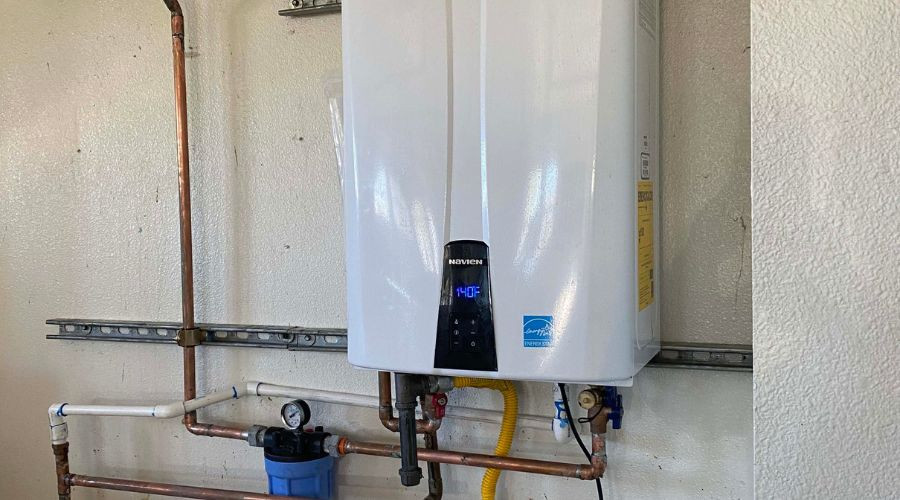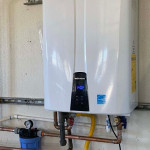Why Go Tankless?
The benefits of installing a tankless water heater include improved energy efficiency and lower bills. For those dealing with unpredictable utility costs and inconsistent hot water, this innovative solution provides reliable performance and ease. Instant, energy-saving comfort becomes possible—without bulky storage tanks. A powerful upgrade like this can transform daily routines and enhance overall comfort.
Energy Efficiency
 Tankless water heaters offer remarkable energy efficiency compared to conventional storage models, potentially reducing water heating costs by 24–34% for homes using less than 41 gallons daily. These on-demand systems eliminate standby heat loss—the energy used to keep 40–50 gallons of water hot constantly—by heating water only when needed. This efficient process creates immediate utility savings.
Tankless water heaters offer remarkable energy efficiency compared to conventional storage models, potentially reducing water heating costs by 24–34% for homes using less than 41 gallons daily. These on-demand systems eliminate standby heat loss—the energy used to keep 40–50 gallons of water hot constantly—by heating water only when needed. This efficient process creates immediate utility savings.
Efficiency gains stem from advanced heating technology. Traditional systems cycle on and off to maintain temperature, while tankless models activate only during water use. This on-demand function lowers overall energy consumption. According to the Department of Energy, switching to a tankless system can result in savings of $100 or more annually on water heating costs.
Long-term benefits extend beyond utility savings. Tankless systems generally carry energy factor (EF) ratings between 0.82 and 0.98, compared to the 0.60 average of conventional units. These ratings indicate better performance, particularly during low-usage periods such as vacations or weekdays. When properly sized, a tankless system offers consistent hot water while minimizing energy waste—striking a balance between comfort and conservation.
Endless Hot Water Supply and Space Savings
 Tankless water heaters deliver an endless supply of hot water on demand, removing the limits imposed by conventional storage systems. Water is heated instantly as it flows through the system—no preheated tank required. The system activates immediately when a hot water tap is opened, offering seamless support for back-to-back showers, laundry, or dishwashing.
Tankless water heaters deliver an endless supply of hot water on demand, removing the limits imposed by conventional storage systems. Water is heated instantly as it flows through the system—no preheated tank required. The system activates immediately when a hot water tap is opened, offering seamless support for back-to-back showers, laundry, or dishwashing.
The technology relies on cold water traveling through a pipe into the tankless unit, where powerful electric or gas heating elements raise it to the desired temperature. With no stored hot water, heat loss is minimized, and temperature consistency improves. This design eliminates the waiting periods and temperature drops often experienced with traditional systems.
For households with high hot water demand or frequent simultaneous usage, tankless units easily adapt. Showers, appliances, and faucets can operate without depleting a reservoir. Scheduling water use becomes unnecessary, and recovery times are eliminated. Continuous hot water becomes a standard convenience.
Space efficiency is another key benefit. Tankless systems do not require a storage tank and are compact enough to mount on walls. Their small footprint frees up square footage in utility areas such as garages, basements, or closets. A typical unit measures about 28 inches tall by 20 inches wide and 10 inches deep—significantly smaller than tank models that can consume up to 16 square feet of floor space.
These compact systems can also be installed in unconventional locations like crawl spaces or outdoors with proper weatherproofing, increasing layout flexibility. With no need for a large water tank, previously occupied space becomes available for storage or other upgrades. Improved space utilization enhances both functionality and home design.
Longer Life Expectancy
Tankless water heaters typically last over 20 years with routine maintenance—nearly double the service life of conventional tank models. This extended lifespan adds long-term value by reducing replacement frequency and associated costs. Most storage water heaters require replacement after 10–15 years, leading to recurring expenses and potential disruption.
Durability results from design differences. Without a constantly full tank exposed to thermal cycling and corrosion, tankless systems face fewer stress-related failures. High-quality heat exchangers and durable components support extended use. Regular flushing and part checks help maintain peak performance over time.
Consumer Reports data suggests a savings of approximately $1,700 over 20 years when avoiding an extra replacement cycle by choosing tankless technology. These savings account for equipment, installation labor, and potential emergency service. Additionally, many tankless units feature modular construction, making individual part replacement possible—eliminating the need for full system replacement and supporting sustainable maintenance practices.
Chris Wilson Plumbing & Heating Repairs Inc
Chris Wilson Plumbing & Heating Repairs Inc is a trusted plumbing and HVAC maintenance company serving the Monterey & Santa Cruz Counties area. They offer 24/7 emergency service, upfront pricing, and respectful technicians. Call them for tankless water heater installation and repair in Seaside, CA.



